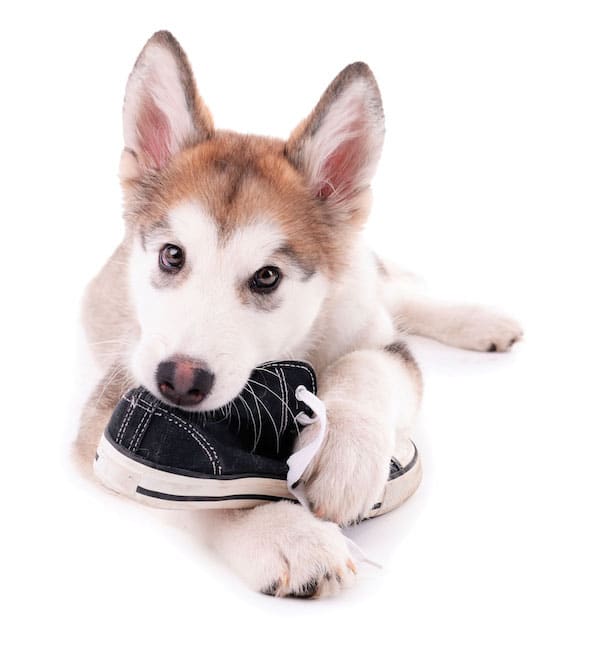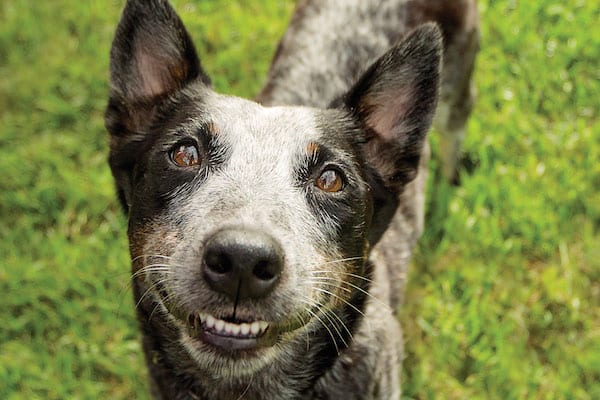Editor’s note: Have you seen the Dogster print magazine in stores? Or in the waiting room of your vet’s office? This article appeared in our February-March issue. Subscribe to Dogster and get the bimonthly magazine delivered to your home.
Tooth trouble — it’s not something you want for your dog. But what can you do to prevent it?
Dogs can suffer from a variety of dental problems at their different life stages. By keeping an eye on your dog’s teeth, you can head some of these problems off and even prevent some from happening.
Puppyhood
Puppies are all about their teeth. My dog, Mookie, was a virtual chewing machine when he was a baby. We nicknamed him “The Croc” because his mouth was always open, looking for the next item to chomp on.
When puppies start switching from their baby teeth to adult dentition, a few problems can occur:
Too many teeth. Puppies are born with 28 deciduous (baby) teeth under the gum, which begin erupting at 2 weeks until they are all visible at 8 weeks. In most cases, at 8 to 12 weeks, the baby teeth start to fall out and are replaced by 48 adult teeth.
In some cases, the baby teeth fail to fall out, and the puppy ends up with too many teeth in his mouth. Having extra teeth is bad because the adult teeth become crowded and may grow at weird angles. Food can also get caught between the teeth and cause gum disease. Puppies who have retained deciduous teeth by the age of 6 months should see a veterinarian to have them removed.

Broken teeth. Puppies like to chew on everything from socks to rocks. If your puppy gnaws on something hard, he can break a tooth. This includes chews and dog toys that are too firm and don’t “give” when the puppy bites down on them. (If you can’t bend it, it’s too hard for your puppy to chew.) If a tooth breaks far enough down, the root canal could be exposed, with a huge potential for infection. If this happens, a veterinary dentist needs to fit your dog with a crown — the same kind you’d get if you had a cavity.
The best way to keep your puppy’s teeth healthy is to give him soft toys and chews to gnaw on. Examine his mouth regularly, and contact your veterinarian right away if you see retained baby teeth or a broken tooth.
Adulthood
By the time your dog is an adult, he will have all his teeth, along with a strong jaw for chewing. He’ll use his teeth for gnawing on toys, chomping down on food, and nibbling on his own skin when he’s itchy.
Because full-grown dogs have had their teeth for some time, they have the potential for a few different dental problems. They can break a tooth just like a puppy can. They can also develop gum disease and worn-down teeth.
Gum disease. Just as with humans, dogs are prone to periodontal disease. If the plaque and calculus that forms on their teeth is not cleaned regularly, dogs can develop painful gum disease that can result in tooth loss and chronic mouth pain. Caused by bacteria growing under the gum line, periodontal disease results when the dog’s immune system attacks the bacteria and releases enzymes that break down the gum tissue. Prevention is key when it comes to gum disease and requires that dogs have their teeth brushed every day. They also need regular visits to the vet, who will decide if it’s time for a thorough cleaning.
Worn teeth. Dogs who like to chew on toys can wear down their teeth. This is especially true of dogs obsessed with tennis balls. While the tennis ball may be the consummate toy for some dogs, the tough material on the outside of the ball can blunt a dog’s teeth over time, especially when it becomes covered with grit and sand. While it may look odd to have a dog with flat-tipped canines, worn teeth are not harmful to the dog as long as the wear is only on the tip of the tooth and doesn’t go all the way down to expose the root. Since that level of wear is very rare, most dog owners don’t have to worry about their dogs chewing to the point of wearing down their teeth.

Blue heeler by Shutterstock.
Old but not out
Senior dogs are most prone to dental problems because their teeth have been around longer. Advanced periodontal disease, abscessed teeth, and tooth loss are among the problems senior dogs are most likely to face.
Advanced periodontal disease. If not addressed, periodontal disease can worsen to the point where loss of bone and gum tissue will result. The infection can also become systemic, affecting vital organs in the dog’s body. Signs of advanced periodontal disease include bad breath; red, swollen gums; visible tartar buildup; wounds on the face near the eye, on the lower jaws, or in the mouth; rubbing the face on objects; loss of appetite; and dropping food. The best way to keep your dog’s mouth from getting to this point is to provide regular dental care in the form of daily brushing and regular vet visits.
Abscessed teeth. If a single tooth becomes infected, it can become abscessed. This usually happens to older dogs and affects the upper canines. A fractured tooth, caused by chewing something hard or being struck in the mouth, can become infected. Frequently check your senior dog’s mouth, and keep an eye out for symptoms of a tooth abscess, including bad breath, chewing on one side of the mouth, dropping food while chewing, pawing at one side of the mouth, and swelling around the eye. Taking good care of your dog’s teeth at all his life stages is the best way to make sure his choppers stay in working order for a very long time.
The post How to Prevent Tooth Troubles at Every Stage of Your Dog’s Life appeared first on Dogster.
No comments:
Post a Comment